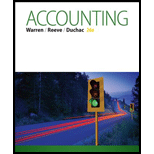
1. a)
Financial Ratios: Financial ratios are the metrics used to evaluate the liquidity, capabilities, profitability, and overall performance of a company.
Given info: Items of financial statement
The Return on total assets for five years (2012 to 2016).
1. a)
Explanation of Solution
Return on assets determines the particular company’s overall earning power. It is determined by dividing sum of net income and interest expense and average total assets.
Formula:
Return on total assets for five years (2012 to 2016) is calculated as below:
b)
The Return on stockholders’ equity for five years (2012 to 2016).
b)
Explanation of Solution
Formula:
Return on stockholders’ equity for five years is calculated as below:
c)
The Number of times interest charges are earned for five years (2012 to 2016).
c)
Explanation of Solution
Number of times interest charges are earned quantifies the number of times the earnings before interest and taxes can pay the interest expense. First, determine the sum of income before income tax and interest expense. Then, divide the sum by interest expense.
Formula:
Number of times interest charges are earned is calculated as below:
d)
The ratio of liabilities to stockholders’ equity for five years (2012 to 2016).
d)
Explanation of Solution
Ratio of liabilities to stockholders’ equity is determined by dividing liabilities and stockholders’ equity. Liabilities are determined as the difference between ending balance of assets and stockholders’ equity.
Formula:
Ratio of liabilities to stockholders’ equity for five years (2012 to 2016) is calculated as below:
2.
To prepare: Analysis of graphs
2.
Explanation of Solution
- The return on total assets and return on stockholders’ equity is negative trend for the last five years. These measures have moved below the industry average. The reason behind this might be due to decline in the amount of earnings earned.
- The use of debt is very evident from the ratio of liabilities to stockholders’ equity and it is in the declining pace.
- The level of debt has been relative to the equity and has improved in the five years.
- The times interest earned ratio is below the industry average.
Want to see more full solutions like this?
Chapter 17 Solutions
Bundle: Accounting, Loose-Leaf Version, 26th + LMS Integrated for CengageNOW, 2 terms Printed Access Card
- Please give me correct answer this financial accounting questionarrow_forwardInternal control in a business organization and the reporting of cash on the balance sheet as well as managing receivables and estimating uncollectible accounts is important. What is internal control, and what are the objectives of a well-designed internal control structure in an organization?arrow_forwardCan you please solve this accounting problem?arrow_forward
- I am looking for a step-by-step explanation of this financial accounting problem with correct standards.arrow_forwardI need help with this general accounting question using standard accounting techniques.arrow_forwardCan you help me solve this general accounting problem with the correct methodology?arrow_forward
 Managerial AccountingAccountingISBN:9781337912020Author:Carl Warren, Ph.d. Cma William B. TaylerPublisher:South-Western College Pub
Managerial AccountingAccountingISBN:9781337912020Author:Carl Warren, Ph.d. Cma William B. TaylerPublisher:South-Western College Pub Managerial Accounting: The Cornerstone of Busines...AccountingISBN:9781337115773Author:Maryanne M. Mowen, Don R. Hansen, Dan L. HeitgerPublisher:Cengage Learning
Managerial Accounting: The Cornerstone of Busines...AccountingISBN:9781337115773Author:Maryanne M. Mowen, Don R. Hansen, Dan L. HeitgerPublisher:Cengage Learning Financial Reporting, Financial Statement Analysis...FinanceISBN:9781285190907Author:James M. Wahlen, Stephen P. Baginski, Mark BradshawPublisher:Cengage Learning
Financial Reporting, Financial Statement Analysis...FinanceISBN:9781285190907Author:James M. Wahlen, Stephen P. Baginski, Mark BradshawPublisher:Cengage Learning Cornerstones of Financial AccountingAccountingISBN:9781337690881Author:Jay Rich, Jeff JonesPublisher:Cengage Learning
Cornerstones of Financial AccountingAccountingISBN:9781337690881Author:Jay Rich, Jeff JonesPublisher:Cengage Learning





